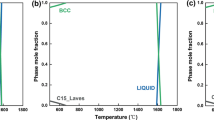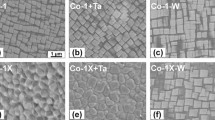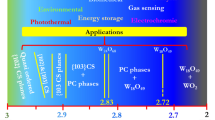Abstract
The effect of quaternary additions of 0.5% Y and 0.5 and 1.0% Th to a base alloy of Ni-10Cr-5Al on the oxidation behavior and mechanism was studied during oxidation in air over the range of 1000–1200°C. The presence of yttrium decreased the oxidation kinetics slightly, whereas the addition of thorium caused a slight increase. Oxide scale adherence was markedly improved by the addition of the quaternary elements. Although a number of oxides formed on yttrium-containing alloys, quantitative x-ray diffraction clearly showed that the rate-controlling step was the diffusion of oxygen through short-circuit paths in a thin layer of alumina that formed parabolically with time. Mixed oxides containing both aluminum and yttrium formed by the reaction of Y2O3 to form YAlOP3 initially, and Y3Al5O12 (YAG) after longer times. Although the scale adherence of the yttrium-containing alloy was considerably better than the base alloys, spalling did occur that was attributed to the formation of the voluminous YAG particles that grew in a “mushroom”-like manner, lifting the protective scale off the substrate locally. The YAG particles formed primarily at grain boundaries in the substrate in which the yttrium originally existed as YNi9. This intermetallic compound reacted to form Y2O3, liberating metallic nickel that subsequently reacted to form NiO or NiAl2O4 spinel or both. The Y2O3 reacted with aluminum to ultimately form the YAG “mushrooms.” Thorium did not form any mixed oxides; the only oxide involving thorium was ThO2, which existed as small particles at the oxide-metal interface. A highly beneficial effect of the thoria particles in reducing film spalling was observed. Scale spalling in the base alloy was attributed to void formation at the oxide-metal interface, the voids forming by condensation of excess vacancies from the Kirkendall effect associated with fast back-diffusion, of nickel into the substrate as aluminum was preferentially oxidized and diffused slowly outward. The mechanism of improved scale adherence in the quaternary alloys was the elimination of voids by annihilation of the Kirkendall vacancies at vacancy sinks introduced by the noncoherent interfaces between yttrium and thorium-containing intermetallics or oxides or both.
Similar content being viewed by others
References
D. L. Douglass,Proc. 1971 Conference of Society of Aerospace Materials and Process Engineers 16, 1 (1971).
D. L. Douglass and J. S. Armijo,Oxid. Met. 2, 207 (1970).
F. S. Pettit,Trans. AIME 239, 1296 (1967).
G. R. Wallwork and A. Z. Hed,Oxid. Met. 3, 171 (1971).
I. Kvernes and P. Kofstad, “Studies on the Behavior of Nickel-Base Superalloys at High Temperatures,” Tech. Rep. AFML-TR-70-103, July 1970.
F. H. Scott and G. C. Wood,Corrosion Sci. 11, 799 (1971).
J. Kuenzly and D. L. Douglass, unpublished research, ARPA Grant No. DAHC-15-70-G-15, UCLA, School of Engineering and Applied Science, Los Angeles, Calif.
R. Kosak, PhD Thesis, The Ohio State University, 1969.
G. J. Santoro, D. L. Deadmore, and C. E. Lowell, “Oxidation of Alloys in the Ni-Al System with Third Element Additions of Cr, Si, and Ti at 1100°C,” NASA-TN-D-6414, July 1971.
A. Taylor and K. G. Hinton,J. Inst. Met. 81, 169 (1952–53).
A. Taylor and R. W. Floyd,J. Inst. Met. 81, 451 (1952–1953).
Y. Oishi and W. D. Kingery, Jr.,J. Chem. Phys. 38, 480 (1960).
J. Pappis and W. D. Kingery,J. Am. Ceram. Soc. 44, 459 (1961).
J. K. Tien and W. H. Rand,Scripta Met. 6, 55 (1972).
J. K. Tien and F. S. Pettit,Met. Trans. 3, 1587 (1972).
J. E. Antill and K. A. Peakall,J. Iron Steel Inst. 205, 1136 (1967).
G. D. Oxx,Product Engg. Jan. 20, 61 (1958).
Battelle Memorial Institute, “Engineering Properties of Selected Ceramic Materials,” American Ceramic Society, Columbus, Ohio, 1966.
M. M. Janssen and G. D. Rieck,Trans. AIME 239, 1372 (1967).
D. Kuhlmann-Wilsdorf, R. Maddin, and H. G. Wilsdorf,Strengthening Mechanisms in Solids (American Society for Metals, Metals Park, Ohio, 1962), p. 137.
R. W. G. Wyckoff,Crystal Structures (Interscience, New York, 1964), Vol. 2, pp. 5 and 395; Vol. 3, pp. 222.
Author information
Authors and Affiliations
Additional information
This work is based on a portion of the dissertation of Arun Kumar in partial fulfillment of the requirements for the degree of Doctor of Philosophy in Engineering, University of California, Los Angeles.
Supported by NASA-Ames under grant No. NGR 05-007-352.
Rights and permissions
About this article
Cite this article
Kumar, A., Nasrallah, M. & Douglass, D.L. The effect of yttrium and thorium on the oxidation behavior of Ni-Cr-Al alloys. Oxid Met 8, 227–263 (1974). https://doi.org/10.1007/BF00604042
Received:
Revised:
Issue Date:
DOI: https://doi.org/10.1007/BF00604042




